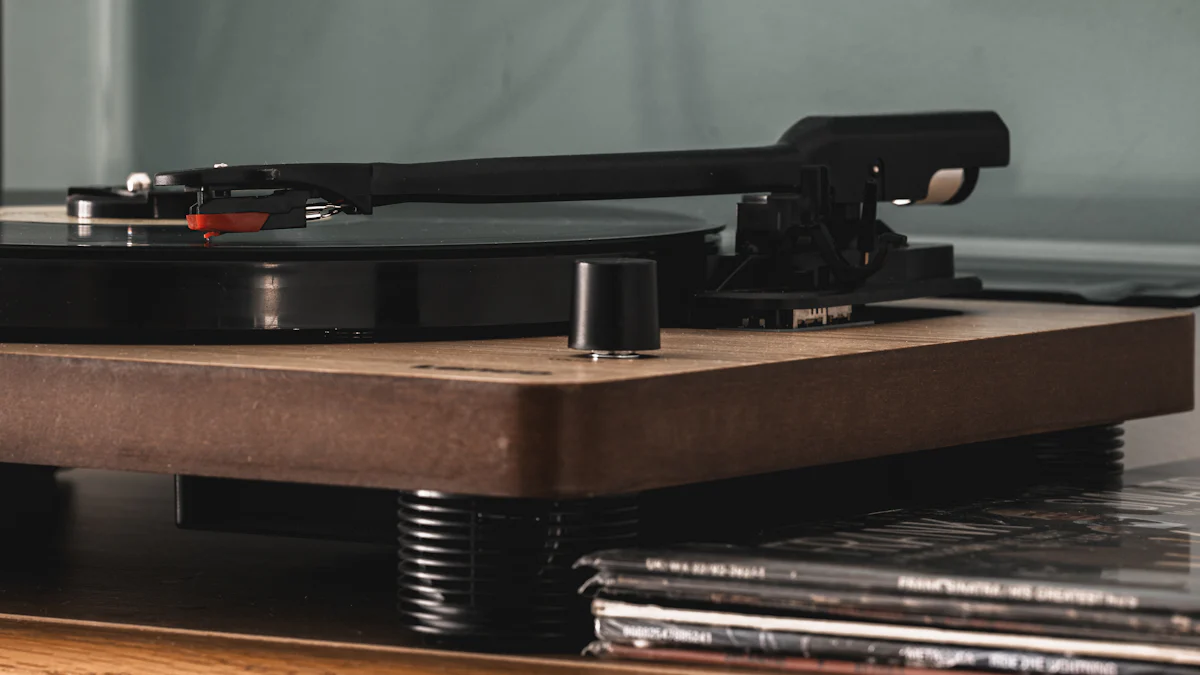Sound Professional on Zoom with Simple Gear

Enhancing your Zoom audio quality doesn't require expensive equipment. Simple gear can make a significant difference in how to sound professional on Zoom calls. You can achieve professional sound by choosing the right tools. Consider using external microphones, which offer clear sound and are great for budget users. USB microphones provide excellent sound with high resolution and multiple settings. These options help you sound professional on Zoom calls. Investing in the right gear ensures your voice comes through clearly, improving communication and making your meetings more effective.
Key Takeaways
- Invest in a quality USB microphone to significantly enhance your audio clarity on Zoom calls.
- Use headphones to reduce echo and improve sound quality, ensuring clear communication during meetings.
- Optimize your Zoom audio settings by testing your microphone and enabling background noise suppression for better sound fidelity.
- Enhance your room acoustics with soft furnishings and strategic furniture placement to minimize echo and improve audio quality.
- Consider using an audio interface if you want to elevate your sound quality with XLR microphones for a professional touch.
- Regularly update your Zoom application to benefit from the latest audio features and improvements.
- Remember that clear audio not only boosts your confidence but also enhances the overall meeting experience for all participants.
Importance of Good Audio
Good audio quality is crucial for effective communication during Zoom calls. It ensures that your speech is clear and easily understandable, which is essential for professional interactions. When you sound professional on Zoom calls, you enhance the overall experience for everyone involved.
Professional Communication
Professional communication relies heavily on clear audio. When your voice is crisp and free from distortion, your message is conveyed accurately. This clarity helps in maintaining the flow of conversation and ensures that your ideas are understood without repetition. Many enterprise organizations emphasize the importance of good audio because it directly impacts meeting outcomes. By investing in simple gear, you can significantly improve your audio quality, making your communication more effective and professional.
Technical Clarity
Technical clarity is another vital aspect of good audio. Clear sound allows participants to focus on the content rather than struggling to understand what is being said. Proper audio settings play a key role in achieving this clarity. Zoom’s default settings are optimized for speech, but customizing them can further enhance your audio quality. This is particularly important for those who share music or other audio content during meetings. By ensuring technical clarity, you make sure that every note and word is heard as intended, which is crucial for music teachers, performers, and anyone aiming to deliver high-quality sound.
Essential Equipment

To sound professional on Zoom calls, you need the right equipment. Investing in quality gear can make a significant difference in your audio experience. Here’s a breakdown of essential equipment that can enhance your Zoom meetings.
Microphones
Choosing the right microphone is crucial for clear and professional audio.
USB Microphones: Easy setup and good quality
USB microphones are a popular choice for their simplicity and quality. They connect directly to your computer, making them easy to set up. The Audio Technica AT2020USB is a favorite among podcasters and educators. It offers excellent sound clarity and doesn't require additional software. This microphone captures detailed audio, ensuring your voice sounds professional on Zoom calls.
Lavalier Microphones: Discreet and portable
Lavalier microphones, also known as lapel mics, are small and clip onto your clothing. They are perfect for those who need mobility during calls. These microphones provide clear sound while remaining unobtrusive. Their portability makes them ideal for presentations or when you need to move around during a meeting.
Headphones
Using headphones can greatly improve your Zoom audio experience.
Reducing echo
Headphones help reduce echo by preventing your microphone from picking up sound from your speakers. This ensures that your voice remains clear and free from feedback. The Audio-Technica ATH-M50x headphones are highly recommended for their durability and sound quality. They are an industry standard for many professionals.
Improving clarity
Headphones also enhance clarity by allowing you to hear others more clearly. This is especially important in noisy environments. By using headphones, you ensure that you don't miss any important details during your meetings.
Audio Interfaces
For those looking to take their audio quality to the next level, audio interfaces are a great option.
Basic interfaces for XLR microphones
Audio interfaces allow you to use XLR microphones, which are known for their superior sound quality. These interfaces come in various sizes, from single mic inputs to larger setups with multiple inputs. They are perfect for blending different audio sources, such as a backing track with live vocals. Interfaces provide flexibility and high-quality audio, helping you sound professional on Zoom calls.
By selecting the right equipment, you can significantly improve your Zoom audio quality. Whether you choose a USB microphone, headphones, or an audio interface, each piece of gear plays a vital role in ensuring you sound professional on Zoom calls.
Additional Tips
Acoustic Treatment
Improving room acoustics can greatly enhance your Zoom audio quality. You don't need to invest in expensive equipment to achieve this. Here are some simple ways to improve the acoustics in your space:
- Use Soft Furnishings: Add rugs, curtains, and cushions to absorb sound. These items help reduce echo and make your voice clearer.
- Position Furniture Strategically: Place bookshelves or other large furniture against walls. This can help break up sound waves and minimize reverberation.
- Hang Wall Art: Canvas prints or fabric wall hangings can also absorb sound. They add aesthetic value while improving acoustics.
- Consider Acoustic Panels: If you want a more professional setup, consider installing acoustic panels. They are effective in reducing noise and echo.
By making these simple changes, you can create a more acoustically friendly environment. This will help you sound professional on Zoom calls.
Software Settings
Optimizing your Zoom audio settings is crucial for achieving clear sound. Here’s how you can adjust these settings for better performance:
- Access Audio Settings: Open Zoom and go to the settings menu. Click on the "Audio" tab to access the audio settings.
- Test Your Microphone: Use the "Test Mic" feature to check your microphone levels. Adjust the input volume to ensure your voice is neither too soft nor too loud.
- Enable Background Noise Suppression: Zoom offers options to suppress background noise. Choose the level that best suits your environment.
- Adjust Advanced Settings: Click on "Advanced" to access more options. Enable "Show in-meeting option to enable Original Sound" for better audio fidelity.
- Regularly Update Zoom: Keep your Zoom application updated. Updates often include improvements to audio features.
By optimizing these settings, you can ensure that your audio is clear and professional. This is an essential step in learning how to sound professional on Zoom calls.
Improving your Zoom audio quality is achievable with the right approach and equipment. By investing in quality microphones, headphones, and audio interfaces, you can significantly enhance your sound. Remember to optimize your Zoom settings and consider simple acoustic treatments for your space. These steps will help you learn how to sound professional on Zoom calls. Try out the suggested gear and tips to experience a noticeable improvement in your communication. Clear audio not only boosts your confidence but also ensures effective interactions during meetings.
FAQ
What is the recommended equipment for using Zoom?
To achieve the best sound quality on Zoom, consider using professional audio equipment. A high-quality USB microphone with noise-cancellation features can significantly enhance your audio experience. Additionally, using headphones helps prevent audio feedback and ensures that the microphone only picks up your voice. Zoom also offers several audio settings, including options for high-quality sound and reducing background noise. Adjusting these settings can further improve your audio quality.
How can I improve my Zoom audio quality?
Improving your Zoom audio quality involves a few key steps:
- Use a Quality Microphone: Invest in a good USB microphone with features like noise-cancellation and a cardioid polar pattern to capture clear audio while minimizing background noise.
- Optimize Microphone Placement: Position the microphone close to your mouth but out of the direct line of breath to avoid popping sounds. Ensure it’s not picking up too much ambient noise.
- Adjust Audio Settings: In Zoom, go to Settings > Audio and ensure “Automatically adjust microphone volume” is unchecked. Manually adjust the microphone gain to avoid distortion. Enable “Suppress background noise” for cleaner audio.
- Use Headphones: Wearing headphones helps prevent audio feedback and ensures that the microphone only picks up your voice.
- Check Your Environment: Choose a quiet location for your calls and use soft furnishings to absorb sound and reduce echo.
Why should I use an external microphone instead of my computer's built-in mic?
Computer audio, meaning the microphone built into your laptop or webcam, doesn't have the quality or fidelity of an independent microphone. An external microphone provides better audio quality and allows you to position it optimally for the best sound delivery. Alternatively, a good quality headset will sound better than the microphone on your computer and isolate your audio from background noise.
Are there specific Zoom settings I should adjust for better audio?
Yes, there are specific settings you can adjust in Zoom to enhance audio quality:
- Test Your Microphone: Use the "Test Mic" feature to check your microphone levels. Adjust the input volume to ensure your voice is neither too soft nor too loud.
- Enable Background Noise Suppression: Zoom offers options to suppress background noise. Choose the level that best suits your environment.
- Adjust Advanced Settings: Click on "Advanced" to access more options. Enable "Show in-meeting option to enable Original Sound" for better audio fidelity.
Can I share computer audio during a Zoom meeting?
Yes, Zoom allows users to share computer audio during screen sharing. This feature is crucial for playing music directly from your computer or sharing any audio content with meeting participants. To do this, simply select the "Share Computer Sound" option when you start sharing your screen.
How does using headphones improve my Zoom call experience?
Headphones improve your Zoom call experience by reducing echo and preventing your microphone from picking up sound from your speakers. This ensures that your voice remains clear and free from feedback. Headphones also enhance clarity by allowing you to hear others more clearly, which is especially important in noisy environments.
What are some simple ways to improve room acoustics for Zoom calls?
Improving room acoustics can greatly enhance your Zoom audio quality. Here are some simple ways to improve the acoustics in your space:
- Use Soft Furnishings: Add rugs, curtains, and cushions to absorb sound. These items help reduce echo and make your voice clearer.
- Position Furniture Strategically: Place bookshelves or other large furniture against walls. This can help break up sound waves and minimize reverberation.
- Hang Wall Art: Canvas prints or fabric wall hangings can also absorb sound. They add aesthetic value while improving acoustics.
By making these simple changes, you can create a more acoustically friendly environment, helping you sound professional on Zoom calls.
See Also
Expert Tips for Hosting Engaging Hybrid Zoom Sessions
12 Creative Zoom Backgrounds to Enhance Your Online Meetings
Comprehensive Zoom Guide: Everything You Need to Know
Step-by-Step Guide to Mastering Computer Audio Visual Skills
